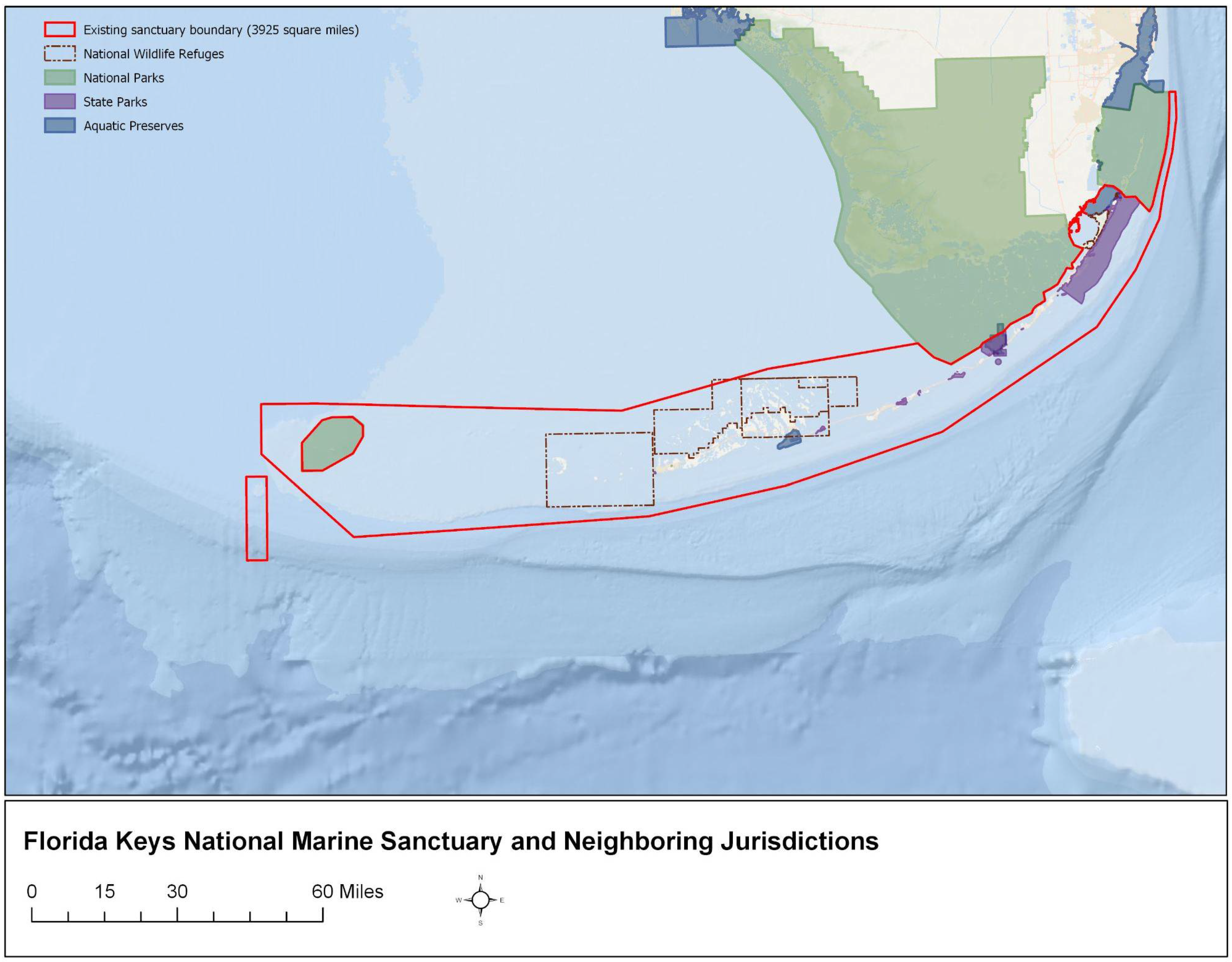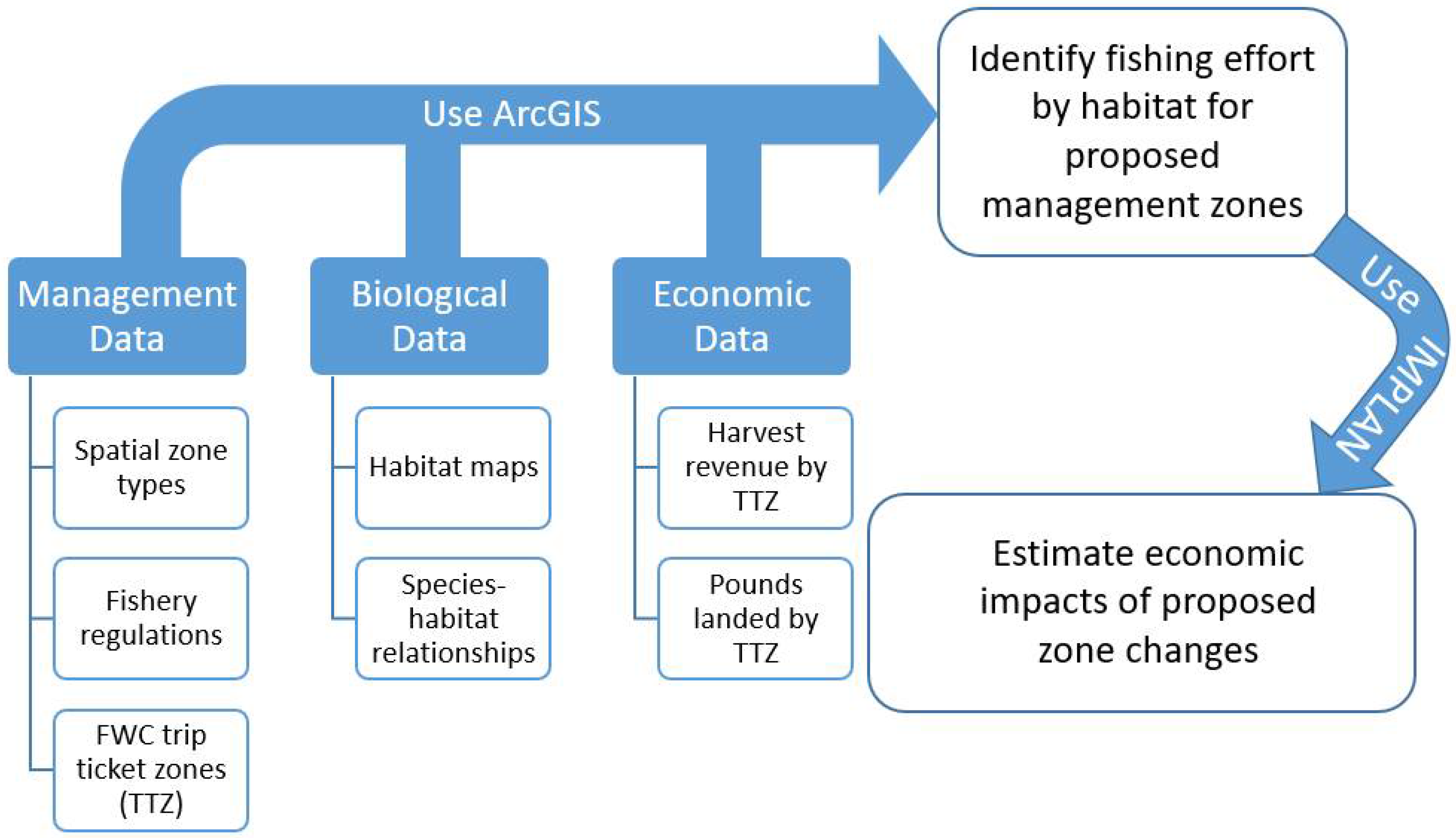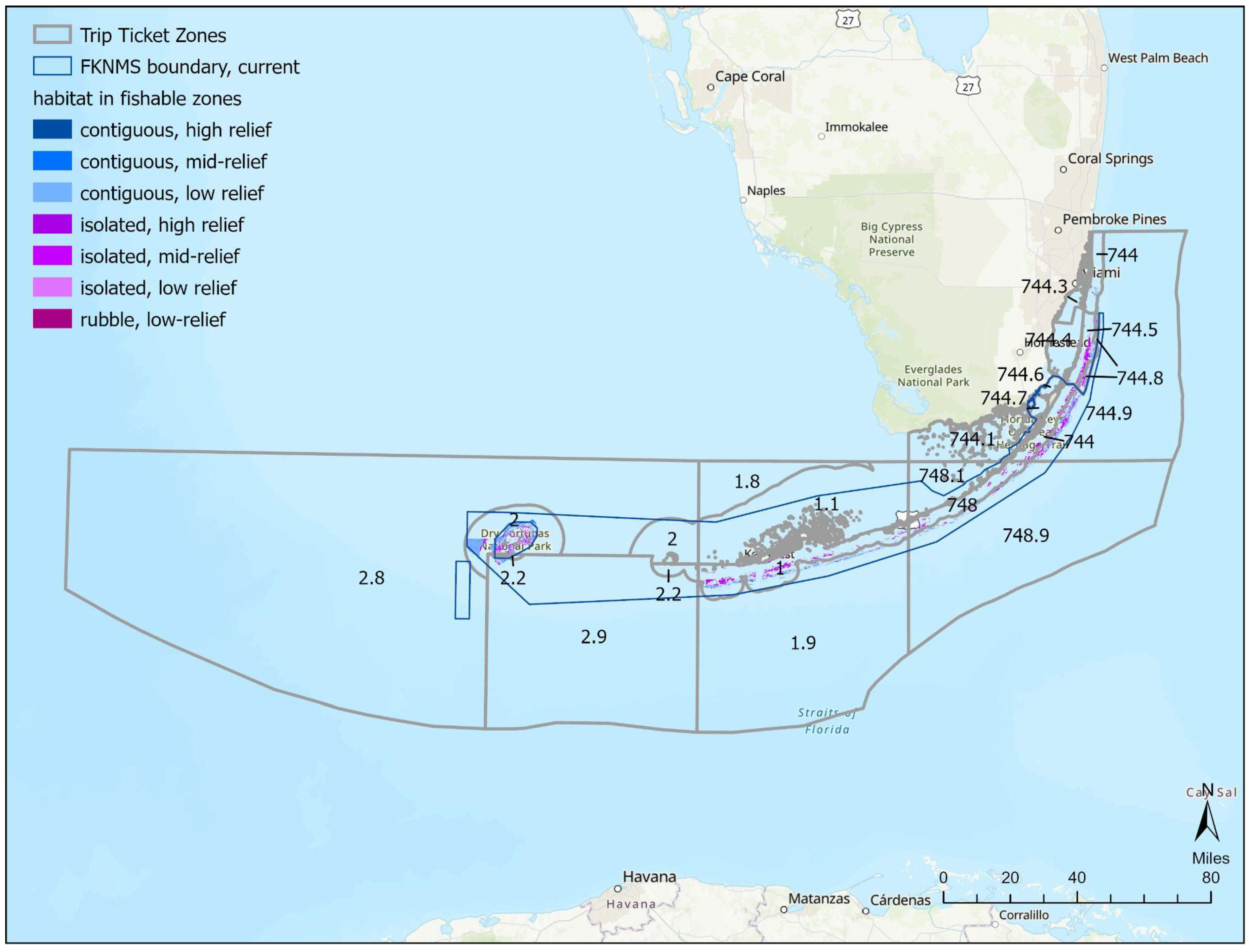Updating the Florida Keys National Marine Sanctuary Management Plan: Estimating the Impact to Commercial Fishing in Monroe County, Florida
Abstract
:1. Introduction
1.1. Ecosystem Structure
1.2. Ecosystem Services
1.3. Restoration Blueprint—Draft Environmental Impact Statement
2. Analysis
2.1. Spatial Analysis: Biogeographic Assessment
2.2. Spatial Analysis: Using Habitat Maps
2.3. Economic Analysis
2.4. Findings
3. Conclusions
3.1. Adaptability to Other Sites and Limitations
3.2. What This Analysis Does Not Include
3.3. Future Work
Author Contributions
Funding
Data Availability Statement
Acknowledgments
Conflicts of Interest
References
- National Marine Sanctuaries About. Available online: https://sanctuaries.noaa.gov/about/ (accessed on 14 June 2021).
- Office of National Marine Sanctuaries. Draft Environmental Impact Statement for Florida Keys National Marine Sanctuary: A Restoration Blueprint; U.S. Department of Commerce, National Oceanic and Atmospheric Administration, Office of National Marine Sanctuaries: Silver Spring, MD, USA, 2019; p. 550.
- How Important Is Tourism to the Florida Keys & Key West. Available online: https://www.monroecounty-fl.gov/DocumentCenter/View/23136/Toursim-Fact-Sheet-?bidId= (accessed on 14 June 2021).
- Smith, S.G.; Ault, J.S.; Bohnsack, J.A.; Harper, D.E.; Luo, J.; McClellan, D.B. Multispecies survey design for assessing reef-fish stocks, spatially explicit management performance, and ecosystem condition. Fish. Res. 2011, 109, 25–41. [Google Scholar] [CrossRef]
- Burke, J.; Judson Kenworthy, W.; Shay Viehman, T.; McDonough, V.; Degan, B. Biodiversity and Ecosystem Function of Shallow Bank Systems within Florida Keys National Marine Sanctuary (FKNMS. Marine Sanctuaries Conservation Series ONMS-12-03; U.S. Department of Commerce, National Oceanic and Atmospheric Administration, Office of National Marine Sanctuaries: Silver Spring, MD, USA, 2011; p. 45.
- Description of Ecosystem Services and Methods to Determine Ratings. Available online: https://sanctuaries.noaa.gov/science/condition/ecosystem.html (accessed on 26 June 2021).
- Leeworthy, V.; Schwarzmann, D.; Shea, R. Florida Keys National Marine Sanctuary: Supporting Analysis for the Restoration Blueprint—Conservation Science Series ONMS 19 06; U.S. Department of Commerce, National Oceanic and Atmospheric Administration, Office of National Marine Sanctuaries: Silver Spring, MD, USA, 2019; p. 228.
- Management 101. Available online: https://sanctuaries.noaa.gov/management/mgt101.html (accessed on 14 June 2021).
- Office of National Marine Sanctuaries. Florida Keys National Marine Sanctuary Condition Report; U.S. Department of Commerce, National Oceanic and Atmospheric Administration, Office of National Marine Sanctuaries: Silver Spring, MD, USA, 2011; p. 105.
- Post-Hurricane Irma images. Available online: https://floridakeys.noaa.gov/whatsnew/releases/2017/post-hurricane-irma-gallery.html (accessed on 27 September 2021).
- Florida’s Coral Reef Disease Outbreak. Available online: https://floridakeys.noaa.gov/coral-disease/ (accessed on 27 September 2021).
- Yarbro, L.A.; Carlson, P., Jr. Executive summary. In Seagrass Integrated Mapping and Monitoring Report No. 2. Fish and Wildlife Research Institute Technical Report TR-17, Version 2; Yarbro, L.A., Carlson, P.R., Jr., Eds.; Florida Fish and Wildlife Conservation Commission: St. Petersburg, FL, USA, 2016; pp. 1–28, 281. [Google Scholar] [CrossRef]
- Revisions of Boundaries, Regulations and Zoning Scheme for Florida Keys National Marine Sanctuary; Revisions of Fish and Wildlife Service and State of Florida Management Agreement for Submerged Lands Within Boundaries of the Key West and Great White Heron National Wildlife Refuges and Regulations; Intent to Prepare a Draft Environmental Assessment or Environmental Impact Statement; Notice of Scoping Meetings. Available online: https://www.federalregister.gov/documents/2012/04/19/2012-9345/revisions-of-boundaries-regulations-and-zoning-scheme-for-florida-keys-national-marine-sanctuary (accessed on 14 June 2021).
- Caldow, C.; Monaco, M.; Pittman, S.; Kendall, M.; Goedeke, T.; Menza, C.; Kinlan, B.; Costa, B. Biogeographic assessments: A framework for information synthesis in marine spatial planning. Mar. Policy 2015, 51, 423–432. [Google Scholar] [CrossRef]
- Commercial Fisheries Landing in Florida. Available online: https://myfwc.com/research/saltwater/fishstats/commercial-fisheries/landings-in-florida/ (accessed on 27 June 2021).
- Brandt, M.E.; Zurcher, N.; Acosta, A.; Ault, J.S.; Bohnsack, J.A.; Feeley, M.W.; Harper, D.E.; Hunt, J.H.; Kellison, G.T.; McClellan, D.B.; et al. A Cooperative Multi-Agency Reef Fish Monitoring Protocol for the Florida Keys Coral Reef Ecosystem NPS/SFCN/NRR-2009/150; U.S. Department of Interior, National Park Service, Natural Resource Program Center: Fort Collins, CO, USA, 2009; p. 110.
- Commercial Fisheries Landings Summaries. Available online: https://public.myfwc.com/FWRI/PFDM/ReportCreator.aspx (accessed on 14 June 2021).
- National Marine Fisheries Service. A User’s Guide to the National and Coastal State I/O Model; Department of Commerce, National Fisheries Service: Silver Spring, MD, USA, 2011; p. 39.
- California Department of Fish and Wildlife. The First Five Years of Monitoring the Channel Islands Marine Protected Area Network—February 7-8, 2008; State of California, California Department of Fish and Wildlife: Sacramento, CA, USA, 2008. Available online: https://www.wildlife.ca.gov/Conservation/Marine/MPAs/Planning-Process-HistoricalInformation/Channel-Islands-MPAs-Monitoring (accessed on 20 May 2021).
- Jeffrey, C.F.G.; Leeworthy, V.R.; Monaco, M.E.; Piniak, G.; Fonseca, M. (Eds.) An Integrated Biogeographic Assessment of Reef Fish Populations and Fisheries in Dry Tortugas: Effects of No-take Reserves. NOAA Technical Memorandum NOS NCCOS 111; Department of Commerce, National Oceanic and Atmospheric Administration, National Center for Coastal and Ocean Science, Center for Coastal Monitoring and Assessment Biogeography Branch: Silver Spring, MD, USA, 2012; p. 147. Available online: http://sanctuaries.noaa.gov/science/socioeconomic/floridakeys/pdfs/tortugasassessmentreport_final.pdf (accessed on 14 June 2021).
- Chan, H.L. Economic impacts of Papahānaumokuākea Marine National Monument expansion on the Hawaii longline fishery. Mar. Policy 2020, 115, 103869. Available online: https://www.sciencedirect.com/science/article/pii/S0308597X19300090 (accessed on 1 June 2021). [CrossRef]
- Johns, G.M.; Leeworthy, V.R.; Bell, F.; Bonn, M.A. Socioeconomic Study of Reefs in Southeast Florida: South Florida; State of Florida, Florida Fish and Wildlife Conservation Commission & Department of Commerce, National Oceanic and Atmospheric Administration: Silver Spring, MD, USA, 2001.
- Florida’s Coral Reef Disease Outbreak. Available online: https://mote.org/research/program/coral-health-and-disease/florida-coral-disease-outbreak (accessed on 1 August 2021).
- Post-Hurricane Irma Images. Available online: https://www.usgs.gov/media/galleries/hurricane-irma-pre-and-post-storm-photo-comparisons-florida-keys (accessed on 1 August 2021).



| Species | Baseline Status Quo Activity | Alternatives 2 and 3 Net Change | Alternative 4 Net Change | Proposed Rule Net Change |
|---|---|---|---|---|
| Black grouper revenue | $403,367 | −$90 | −$13,443 | −$1343 |
| Black grouper pounds | 84,539 | −19 | −2711 | −283 |
| Red grouper revenue | $1,659,793 | −$13 | −$21,772 | −$389 |
| Red grouper pounds | 445,373 | −3 | −5837 | −96 |
| Grunts revenue | 14,905 | −$7 | −$722 | −$53 |
| Grunts pounds | 12,028 | −5 | −665 | −41 |
| Hogfish revenue | $44,128 | −$41 | −$1389 | $305 |
| Hogfish pounds | 9800 | −9 | −320 | −70 |
| Gray snapper revenue | $302,068 | −$21 | −$21,660 | −$726 |
| Gray snapper pounds | 110,552 | −7 | −8806 | −259 |
| Lane snapper revenue | $19,086 | $0 | −$891 | −$22 |
| Lane snapper pounds | 7215 | 0 | −472 | −10 |
| Mutton snapper revenue | $337,168 | −$129 | −$13,270 | −$1539 |
| Mutton snapper pounds | 109,547 | −36 | −4368 | −435 |
| Yellowtail snapper revenue | $7,432,618 | −$1149 | −$877,682 | −$16,839 |
| Yellowtail snapper pounds | 2,289,397 | −345 | −256,187 | −5221 |
| Lobster revenue | $42,004,990 | −$1802 | −$955,666 | −$965,833 |
| Lobster pounds | 5,023,736 | −207 | −102,200 | −115,236 |
| Gag grouper revenue | $145,776 | −$3 | −$2922 | −$53 |
| Gag grouper pounds | 30,800 | −1 | −615 | −11 |
| Stone crab revenue | $20,159,926 | −$13,728 | $118,735 | −$37,714 |
| Stone crab pounds | 1,443,427 | −931 | −8356 | −2564 |
| Shrimp revenue | $20,884,677 | $42 | −$9467 | $5 |
| Shrimp pounds | 8,951,302 | 18 | −3999 | 2 |
| Alternative | Average Ex-Vessel Value ($ Thousands) | Total Jobs | Harvester Jobs | Output (Sales) Impacts ($ Thousands) | Income Impacts ($ Thousands) | Value Added ($ Thousands) |
|---|---|---|---|---|---|---|
| No action (baseline) | $93,409 | 1722 | 2752 | $921,761 | $337,934 | $478,379 |
| Alternative 2 net change | −$17 | −2 | −1 | −$168 | −$62 | −$88 |
| Alternative 3 net change | −$17 | −2 | −1 | −$168 | −$62 | −$88 |
| Alternative 4 net change | −$2038 | −258 | −62 | −$20,210 | −$7463 | −$10,536 |
| Proposed rule net change | −$1025 | −130 | −32 | −$10,168 | −$3773 | −$5324 |
| Alternative | Average Ex-Vessel Value ($ Thousands) | Total Jobs | Harvester Jobs | Output (Sales) Impacts ($ Thousands) | Income Impacts ($ Thousands) | Value Added ($ Thousands) |
|---|---|---|---|---|---|---|
| No action (baseline) | $93,409 | 3741 | 2423 | $385,429 | $101,683 | $156,200 |
| Alternative 2 net change | −$17 | −1 | 0 | −$68 | −$19 | −$28 |
| Alternative 3 net change | −$17 | −1 | 0 | −$68 | −$19 | −$28 |
| Alternative 4 net change | −$2038 | −84 | −56 | −$8215 | −$2251 | −$3405 |
| Proposed rule net change | −$1025 | −42 | −28 | −$4130 | −$1133 | −$1713 |
Publisher’s Note: MDPI stays neutral with regard to jurisdictional claims in published maps and institutional affiliations. |
© 2022 by the authors. Licensee MDPI, Basel, Switzerland. This article is an open access article distributed under the terms and conditions of the Creative Commons Attribution (CC BY) license (https://creativecommons.org/licenses/by/4.0/).
Share and Cite
Schwarzmann, D.; Freitag, A.; Dorfman, D.; Records, D.; Walz, M. Updating the Florida Keys National Marine Sanctuary Management Plan: Estimating the Impact to Commercial Fishing in Monroe County, Florida. Water 2022, 14, 290. https://doi.org/10.3390/w14030290
Schwarzmann D, Freitag A, Dorfman D, Records D, Walz M. Updating the Florida Keys National Marine Sanctuary Management Plan: Estimating the Impact to Commercial Fishing in Monroe County, Florida. Water. 2022; 14(3):290. https://doi.org/10.3390/w14030290
Chicago/Turabian StyleSchwarzmann, Danielle, Amy Freitag, Dan Dorfman, David Records, and Meredith Walz. 2022. "Updating the Florida Keys National Marine Sanctuary Management Plan: Estimating the Impact to Commercial Fishing in Monroe County, Florida" Water 14, no. 3: 290. https://doi.org/10.3390/w14030290
APA StyleSchwarzmann, D., Freitag, A., Dorfman, D., Records, D., & Walz, M. (2022). Updating the Florida Keys National Marine Sanctuary Management Plan: Estimating the Impact to Commercial Fishing in Monroe County, Florida. Water, 14(3), 290. https://doi.org/10.3390/w14030290






